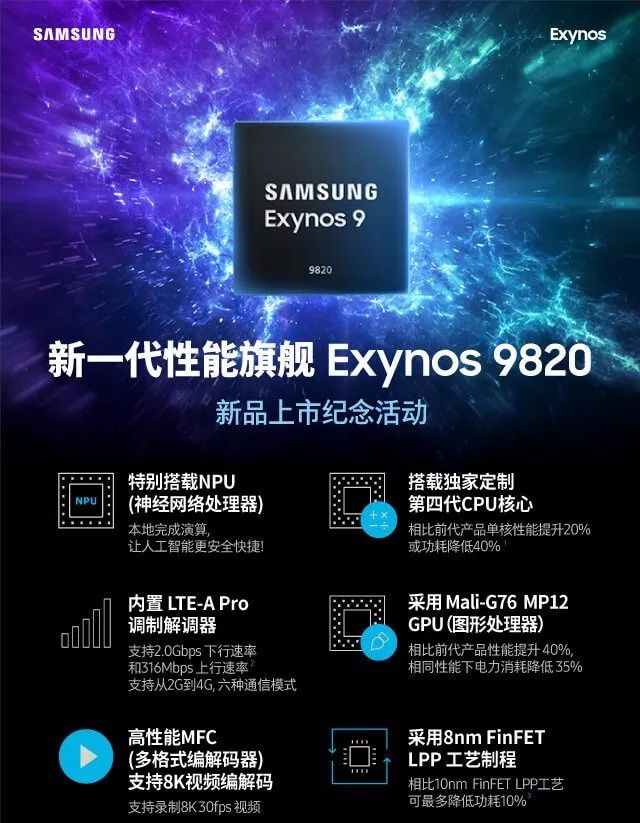

Today, I received a Weibo push notification that I found quite interesting. It was about the launch event of the Exynos 9820 mobile processor from South Korea. This processor was actually released back on November 14, 2018, making it old news. However, a blogger I follow reposted it, and Weibo brought it back to my attention. The blog mentioned comparisons to Apple’s A12, kicking Qualcomm’s Snapdragon 8150, and punching Huawei’s Kirin 980, etc. I have no interest in buying a Samsung phone and had almost forgotten to keep track of Samsung’s mobile processors. Recently, I’ve only focused on the S5P6818 main control from Samsung, which I had to look into while selecting a core board for a project.

I was initially prepared to skim through the post, but I was attracted by a statement in one of the images: “Compared to the previous generation, the CPU has a single-core performance improvement of 20% or a power consumption reduction of 40%. The GPU has a performance improvement of 40% with a 35% reduction in power consumption at the same performance level.”
This is a very interesting statement 😂. Since I started working with computers, I have heard CPU manufacturers claim every year that their new generation CPUs use more advanced process technologies (the more advanced the CPU process technology, the lower the power consumption and temperature, and the higher the processor frequency can be increased), promising a percentage reduction in power consumption compared to the previous generation.
From the initial Pentium at 0.35 microns to today’s 7 nanometers, the process technology has advanced many generations. Even if each generation only reduces power consumption by 10%, today’s CPUs should hardly consume any electricity 😂. However, thinking about it, something feels off. Why does it seem like the power supply wattage for PCs is increasing? Initially, I think we used 200W power supplies, but now desktop power supplies generally start at four or five hundred watts. The same goes for mobile processors; I remember when using Nokia phones, they would last two or three days on a single charge, but now mobile battery capacities are increasing while daily charging has become the norm.
Improving process technology can certainly reduce IC power consumption, but in pursuit of higher performance, more transistors need to be packed in, which increases power consumption.
Therefore, in IC design, there is often a need to pursue a balance between power consumption, speed, and area..
-
Power Consumption: The energy consumed by the circuit during operation. The lower the power consumption, the more energy-efficient the chip is, leading to lower heat generation and environmental friendliness.
-
Speed: The maximum clock frequency (in MHz) that the circuit can achieve. Generally speaking, the faster the speed, the more data can be processed, resulting in better performance.
-
Area: The physical space occupied by the circuit on the silicon wafer. The smaller the area occupied, the lower the cost.
Power consumption, speed, and area are interrelated. Under the same manufacturing process conditions, generally speaking:
-
The faster the speed, the larger the transistor size, which increases the area and power consumption.
-
To reduce power consumption, the operating speed of the chip can be lowered, resulting in a slower clock transition frequency.
-
To reduce costs and chip area, smaller (W smaller) transistors can be used. Since current is proportional to W, reducing area results in slower speed. (To reduce area while improving speed, L must be made smaller, meaning the process must be improved, such as transitioning from 65nm to 45nm, then from 45nm to 28nm, etc.)
-
To increase speed, we need to increase the charging current. Increasing current inevitably leads to increased power consumption. (To increase speed without increasing current, capacitance must be reduced or charging voltage lowered; these two actions also rely on improvements in process technology, such as transitioning from 45nm to 28nm processes.)
Regarding the interrelation of power consumption, speed, and area in IC design, I thought of the book “Low Power Design Essentials” by Jan Rabaey, published in 2009. It has been ten years since then, but classics remain classics.
There is also an excellent discussion on Zhihu about how much power consumption limits processors, which I recommend to everyone: https://zhuanlan.zhihu.com/p/20808891

High-End WeChat Group Introduction
|
Entrepreneurial Investment Group |
AI, IOT, Chip Founders, Investors, Analysts, Brokers |
| Flash Memory Group | Covering over 5000 global Chinese flash memory and storage chip elites |
|
Storage Group |
All-flash, Software-defined Storage (SDS), Hyper-converged, and other enterprise storage |
|
AI Chip Group |
Discussion on AI chips and GPU, FPGA, CPU heterogeneous computing |
|
IoT Group |
Discussion on IoT, 5G technology, and industry |
|
ASIC Group |
Discussion group on chip and FPGA hardware technology |
|
Storage Chip Group |
Discussion on various storage media and controllers such as DRAM, NAND, 3D XPoint |
|
CIO Group |
Discussion on enterprise information technology |
|
Channel Group |
Storage product pricing, market conditions, channels, and supply chain |


